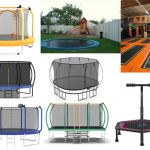- 1-Mechanics-of-Trampoline-Workouts
- 2-Core-Engagement-During-Trampoline-Exercises
- 3-Specific-Trampoline-Core-Workouts-and-Benefits
- 4-Real-Life-Experiences-with-Trampoline-Core-Training
- 5-Expert-Advice-on-Maximizing-Core-Strength-with-Trampolines
- 6-Finding-the-Best-Trampoline-for-Core-Workouts
1. Mechanics of Trampoline Workouts
Understanding how trampoline workouts affect your core starts with grasping the unique mechanics involved. Unlike traditional floor exercises, trampoline workouts create an unstable surface that constantly challenges your body’s balance and coordination.
When you jump or perform moves on a trampoline, your core muscles must engage continuously to stabilize your torso and maintain posture. This dynamic environment stimulates deep abdominal muscles and lower back muscles more effectively than many conventional workouts.
2. Core Engagement During Trampoline Exercises
Core engagement is essential for controlling your movements on the trampoline. Each bounce requires micro-adjustments from the abdominal muscles, obliques, and pelvic floor to keep balance and absorb impact.
This constant activation leads to improved muscle tone and endurance in the core area. Additionally, trampoline exercises encourage better posture and spinal alignment because your core works to support your entire body throughout the workout.
3. Specific Trampoline Core Workouts and Their Benefits
Trampoline workouts designed to target the core include moves like tuck jumps, plank variations on the trampoline surface, and seated bounce exercises. These exercises challenge stability and strengthen the core from multiple angles.
Benefits include enhanced balance, improved flexibility, and increased calorie burn due to the full-body engagement. For example, performing Russian twists on a trampoline intensifies oblique muscle activation, offering a more effective core workout than doing them on the ground.
4. Real-Life Experiences with Trampoline Core Training
Consider Jessica, who incorporated trampoline workouts into her routine to recover core strength after childbirth. She found that the low-impact yet intense core activation helped her regain muscle tone without strain.
Similarly, athletes use trampoline training to boost core stability and prevent injuries. Stories like these underscore the trampoline’s versatility as a tool for core strengthening across different fitness levels and goals.
5. Expert Advice on Maximizing Core Strength with Trampolines
Experts recommend starting with basic jumps focusing on maintaining tight abdominal engagement. Gradually introducing complex movements like pikes or jumps with twists increases core challenge and coordination.
Consistency is key—regular trampoline workouts combined with a balanced diet and overall fitness plan yield the best core strengthening results. Listening to your body and progressing safely helps prevent injury while maximizing gains.
6. Finding the Best Trampoline for Core Workouts
Choosing the right trampoline can enhance how trampoline workouts affect your core. Look for trampolines with sturdy frames, strong springs, and an optimal bounce height that suits your skill level and workout intensity.
For personalized recommendations and high-quality trampolines designed to support core fitness, visit Trampoline Zone. Their expert guides and product selections help you find equipment tailored to your needs, ensuring effective and enjoyable workouts.







 Pump It Up Lake Forest Kids Birthday and More4.0 (280 reviews)
Pump It Up Lake Forest Kids Birthday and More4.0 (280 reviews) Urban Air Trampoline and Adventure Park4.0 (349 reviews)
Urban Air Trampoline and Adventure Park4.0 (349 reviews) Church Street Plaza4.0 (731 reviews)
Church Street Plaza4.0 (731 reviews) Fun City Adventure Park3.0 (162 reviews)
Fun City Adventure Park3.0 (162 reviews) Riki Tiki's Indoor PlayGround4.0 (35 reviews)
Riki Tiki's Indoor PlayGround4.0 (35 reviews) Urban Youth Park - South Bay4.0 (107 reviews)
Urban Youth Park - South Bay4.0 (107 reviews) Are Trampoline Parks Safe for Kids? Essential Guide for U.S. Parents
Are Trampoline Parks Safe for Kids? Essential Guide for U.S. Parents How Often Should You Replace Trampoline Springs? Tips for Proper Maintenance
How Often Should You Replace Trampoline Springs? Tips for Proper Maintenance How Much Is a Trampoline? A Detailed Guide to Trampoline Costs and Buying Tips
How Much Is a Trampoline? A Detailed Guide to Trampoline Costs and Buying Tips Bounce Techniques for Stronger Legs: Effective Exercises and Tips
Bounce Techniques for Stronger Legs: Effective Exercises and Tips Essential Music Gear for Trampoline Dance: Complete Guide
Essential Music Gear for Trampoline Dance: Complete Guide Fun STEM Experiments Using Trampolines to Spark Curiosity and Learning
Fun STEM Experiments Using Trampolines to Spark Curiosity and Learning